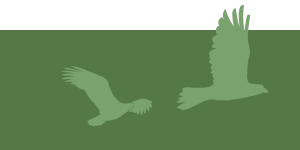
BURROWING OWL RESEARCH AND MONITORING

Much of our work at IBP is based on the premise that a little thoughtful coordination can join the efforts of disparate individuals and groups into something greater than the sum of its parts. This is particularly true for monitoring bird populations where, in many cases, non-professional biologists make important contributions. From 1991-1993, IBP coordinated over 400 volunteers who contributed nearly 7,000 hours to counting Burrowing Owls on 939 study plots across California. Volunteers documented the locations of 1,955 pairs of owls and, just as importantly, where the owls were absent.
At the time, this was the largest volunteer survey ever on a single species in California. Our final report contained regional and statewide population estimates, documenting the species’ decline, and conservation recommendations. This pioneering work led to a cooperative research program on Burrowing Owls in critical areas of California from 1996-2004. The original 1991-93 survey was repeated in 2006-07, with nearly 400 volunteers.
In 2007, IBP Published a monograph on the Burrowing Owl, Proceedings of the California Burrowing Owl Symposium, which included 20 peer-reviewed papers on the species’ ecology, status, distribution, and trend, and a comprehensive bibliography of the Burrowing Owl in California.
For more information about IBP’s past Burrowing Owl work, please contact Bob Wilkerson.
Photo Credits: Top of Page, Wendy Miller; Right panel, Ray Hennessey.
CALIFORNIA-WIDE SURVEYS
The Western Burrowing Owl has declined in recent decades across much of its range, including California, where it is classified as a Species of Special Concern.
During 1991-1993, IBP surveyed the species in California, documenting 1,955 pairs and estimating 9,127 breeding pairs in mainland California exclusive of the Great Basin and desert areas. IBP repeated this survey during 2006 and 2007, this time including the Great Basin and desert areas.
Major patterns of Burrowing Owl occurrence across California appeared to be relatively unchanged between 1993 and 2007, although alarming declines were apparent in the San Francisco Bay and Bakersfield areas. Large aggregations of owls were documented in the Palo Verde Valley and the western Mojave Desert.

SELECTED PUBLICATIONS
Peer-reviewed Publications
Wilkerson, R.L., and R.B. Siegel. 2011. Distribution and abundance of Western Burrowing Owls (Athene cunicularia hypugaea) in southeastern California. The Southwestern Naturalist 56:378-384. PDF
Wilkerson, R.L., and R.B. Siegel. 2010. Assessing changes in the distribution and abundance of burrowing owls in California, 1993-2007. Bird Populations 10:1-36. PDF
Rosenberg, D.K., J.A. Gervais, D.F. DeSante, and H. Ober. 2009. An updated adaptive management plan for the Burrowing Owl population at Naval Air Station Lemoore. The Oregon Wildlife Institute, Corvallis, OR, and The Institute for Bird Populations, Point Reyes Station, CA. PDF
Rosenberg, D.K., and K.L. Haley. 2008. The ecology of Burrowing Owls in the agroecosystem of the Imperial Valley, California. Studies in Avian Biology. PDF
DeSante, D.F., E.D. Ruhlen, and R. Scalf. 2007. The distribution and relative abundance of Burrowing Owls in California during 1991-1993: evidence for a declining population and thoughts on its conservation. Pages 1-41 in: Proceedings of The California Burrowing Owl Symposium. Bird Populations Monograph No. 1.
Gervais, J.A., C.M. Hunter, and R.G. Anthony. 2006. Interactive effects of prey and p,p′-DDE on Burrowing Owl population dynamics. Ecological Applications 16:666–677. PDF
Rosier, J.R., N.A. Ronan, and D.K. Rosenberg. 2006. Post-Breeding dispersal of Burrowing Owls in an extensive California grassland. The American Midlands Naturalist 155:162-167. PDF
DeSante, D.F., E.D. Ruhlen, and D.K. Rosenberg. 2004. Density and abundance of Burrowing Owls in the agricultural matrix of the Imperial Valley, California. Studies in Avian Biology 27:116-119. PDF
Gervais, J.A., and D.H. Catlin. 2004. Temporal patterns of DDE in Burrowing Owl eggs from The Imperial Valley, California. Southwest Naturalist 49:509-512. PDF
Gervais, J.A., D.K. Rosenberg, and R.G. Anthony. 2003. Space use and pesticide exposure risk of male Burrowing Owls in an agricultural landscape. The Journal of Wildlife Management 67:155–164. PDF
Gorman, L.R., D.K. Rosenberg, N.A. Ronan, K.L. Haley, J.A. Gervais, and V. Franke. 2003. Estimation of reproductive rates of Burrowing Owls. The Journal of Wildlife Management 67:493-500. PDF
Gervais, J.A., D.K. Rosenberg, D.M. Fry, L. Trulio, and K.K. Sturm. 2000. Burrowing Owls and agricultural pesticides: evaluation of residues and risks for three populations in California, U.S.A. Environmental Toxicology and Chemistry 19:337–343. PDF
Gervais, J.A, and D.K. Rosenberg. 1999. Western Burrowing Owls in California produce second brood of chicks. The Wilson Bulletin 111:569-571. PDF
Rosenberg, D., J. Gervais, H. Ober, and D. DeSante. 1998. An adaptive management plan for the Burrowing Owl population at Naval Air Station Lemoore, Lemoore, California. The Institute for Bird Populations and The Oregon Cooperative Fish and Wildlife Research Unit. PDF
DeSante, D.F., E.D. Ruhlen, S.L. Adamany, K.M. Burton, and S. Amin. 1997. A census of Burrowing Owls in central California in 1991. The Journal of Raptor Research 9:38-48.
Other Publications and Reports
Rosenberg, D.K., L.D. Tralis, and D.F. DeSante. 1998. The Burrowing Owl demography and space use research study in California: annual report. The Institute for Bird Populations, Point Reyes Station, CA.
Rosenberg, D.K., and D.F. DeSante. 1996. Report on the feasibility of a demographic study of Burrowing Owls in California. 1996. The Institute for Bird Populations, Point Reyes Station, CA.








